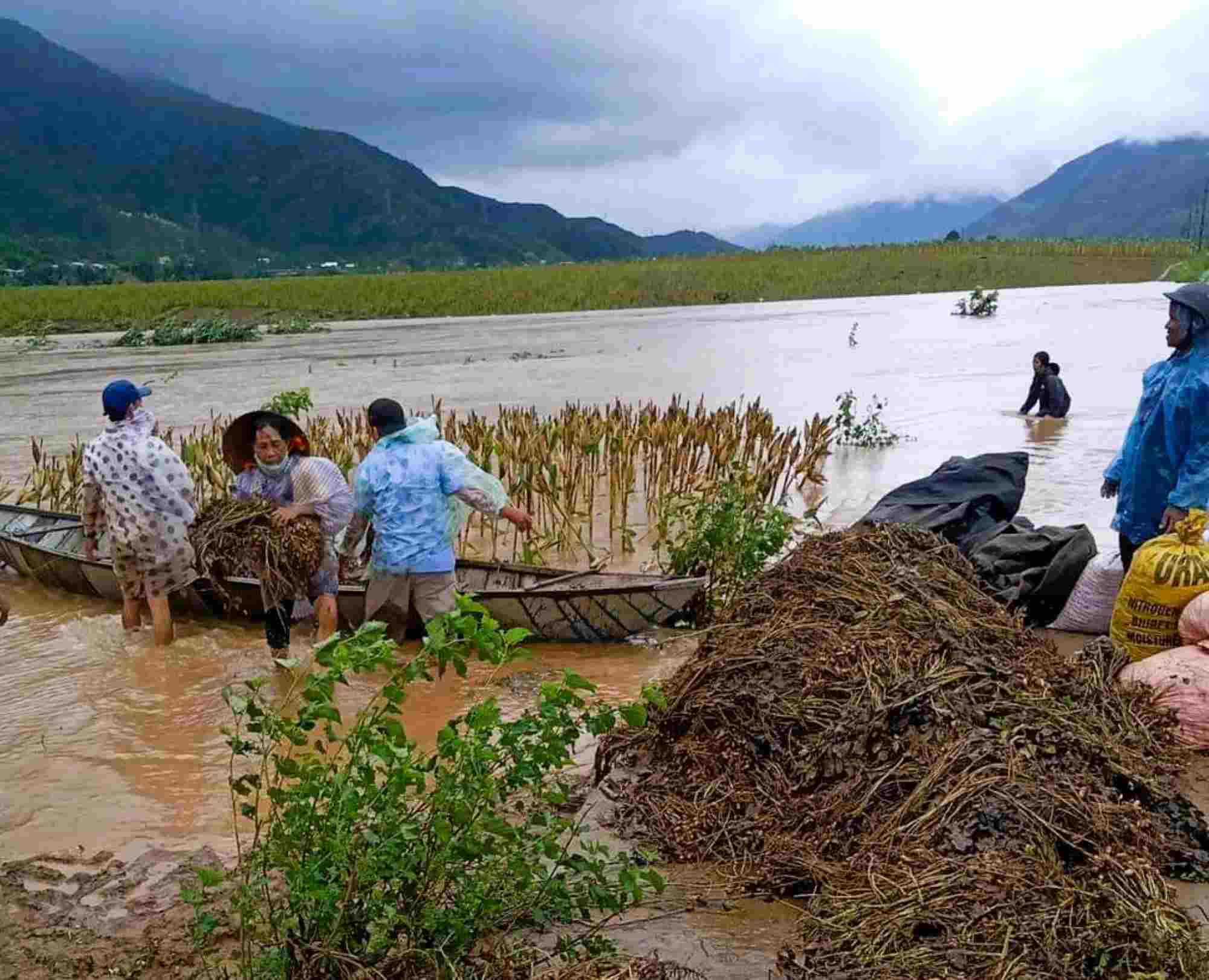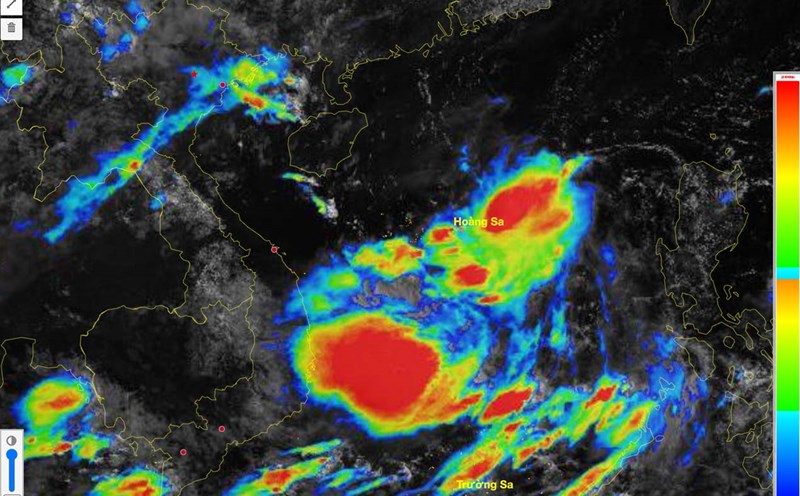
Storm without making landfall still causes serious consequences
According to Ms. Nguyen Hong Phuong - Deputy Director of the Department of Agriculture and Rural Development of Quang Tri province, the damage to rice and crops alone is estimated at 458 billion VND. The locality has submitted a document advising the People's Committee of Quang Tri province to request the Ministry of Agriculture and Rural Development to urgently support 130 tons of Khang Dan rice varieties from the national reserve so that farmers can promptly re-sow the Summer-Autumn crop.
The damage in Quang Tri province did not stop at agriculture, the dyke system, canals and river banks in the plains were also damaged and seriously eroded.
In Hue, the situation is no less serious. According to the preliminary report, the whole province has 22,418 hectares of flooded rice, of which it is expected that about 5,000 to 10,000 hectares will have to be re-sown.

In Quang Binh province, floods have claimed 4 lives, including 2 in Minh Hoa district and 2 in Bo Trach district. Traffic was paralyzed at 34 points due to flooding and isolation; 14 landslides occurred on national highways, provincial roads and the West branch of Ho Chi Minh road. In the agricultural sector, more than 20,800 hectares of rice were flooded, including unharvested winter-spring rice, summer-autumn rice and regenerated rice. More than 400 hectares of crops were flooded and over 1,550 hectares of aquaculture ponds were damaged, not to mention hundreds of cages for fish and oysters were damaged by floods.
Mr. Ho Van Teo (Phiem Ai 2 village, Dai Nghia commune, Dai Loc district, Quang Nam province) was still shocked: "For the past 30 years, I have never witnessed a flood in the middle of summer like this. All 10 sao of watermelon in my family that were close to harvest were submerged in water, causing a loss of nearly 60 million VND. We are completely passive, no one thought there would be a big flood in the middle of summer".

Prevention cannot be passive
According to the National Center for Hydro-Meteorological Forecasting, although storm No. 1 did not make landfall directly, the storm's circulation was very large and interacted strongly with the southwest monsoon, forming a heavy rain axis from Ha Tinh to Hue. Rainfall is generally from 100 - 250mm, in some places over 350mm in just 24 hours, causing waterlogged land, prone to landslides and flooding.
Along with that, the Central region's terrain is inherently steep, the river is short, the plains are narrow, and the ability to drain water is poor, so just 2-3 days of rain is enough to cause widespread flooding and damage all crops, especially rice, during the harvest period. The areas of Summer-Autumn rice are still young, not deeply rooted, making it easier to lose everything.
Meteorological expert Le Thi Xuan Lan warned that many current storms do not need to make landfall, as long as the circulation is strong, it can cause great damage. If subjective, the consequences will be even worse.
In addition to natural factors, the subjective psychology of people and the negligence of some localities also contribute to increased damage. Many people still go to the fields, go down to streams, fish in the heavy rain because they think the storm " won't come". In Quang Binh, 2 people went missing while going into a stream to check for frogs; in Quang Tri, one person died due to electric shock while handling equipment while flooded.
Meanwhile, in some places, the authorities have not promptly issued warnings, proactively organized early evacuation or closely monitored high-risk areas.
Expert Nguyen Van Huong (National Center for Hydro-Meteorological Forecasting) once warned: "We should not only rely on the path of the storm center.Many major floods originated from the circulation located offshore but caused very heavy rain.
Climate change is becoming increasingly clear
Mr. Hoang Nam - Acting Chairman of the People's Committee of Quang Tri province emphasized that climate change is causing more and more extreme weather phenomena to appear. Therefore, relevant units need to consider the overall strategy of investing in drainage infrastructure, canals in the fields, converting adaptative crop varieties, ensuring sustainable livelihoods.
According to Mr. Hoang Nam, in the context of increasingly clear climate change, all plans for agricultural development, infrastructure construction or population allocation need to be placed in a long-term vision.
Mr. Phan Phong Phu - Vice Chairman of the People's Committee of Quang Binh province also requested localities to learn from experience, urgently support farmers in reproducing and providing suitable rice varieties.
Natural disasters today no longer follow the old rules. An un Landing Storm Can Still As Conclusive as a Big Storm. Therefore, localities, authorities and people need to change their preventive thinking: Do not wait for the storm to come, but proactively monitor the circulation, rainfall, flood warnings and prepare evacuation plans, protect assets.
The lesson from storm No. 1 is a reminder at the beginning of this year's rainy season: Just a little subjectivity, the price to pay is not only the dyke, infrastructure, crop, house but also human life.
Speaking to Lao Dong reporter, Mr. Truong Xuan Ty, Deputy Director of the Department of Agriculture and Environment of Quang Nam province emphasized: "The current weather is getting more and more unpredictable, extreme phenomena can happen at any time, not according to traditional rules. People must be more proactive in prevention, especially needing to have flexible production plans to avoid high risks. We encourage people to change the appropriate crop structure, choose short-term, well-cted plant varieties and regularly update weather information to have early response measures".
The Department of Agriculture and Environment is urgently counting the damage and proposing support plans for people. "After this flood, the upcoming crop production will have major fluctuations, the seasonal schedule will be delayed. The Department is calculating and adjusting the seed structure appropriately to promptly support farmers in restoring production" - Mr. Ty said.
In addition, Mr. Ty recommended that people need to develop a plan to evacuate livestock and arrange safe places to promptly respond when floods occur. At the same time, authorities at all levels need to continue to strengthen propaganda and instruct people on disaster response skills to minimize damage.
The recent flood is a valuable lesson for both the government and people of Quang Nam, posing an urgent need to change thinking and action to adapt to increasingly complex and unpredictable climate change.










